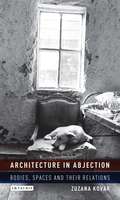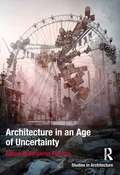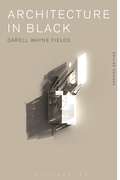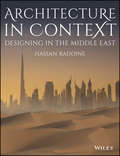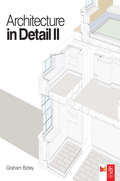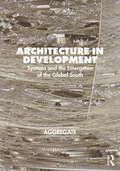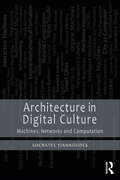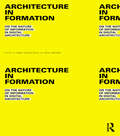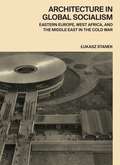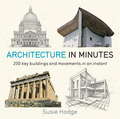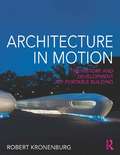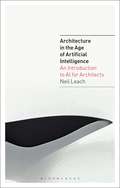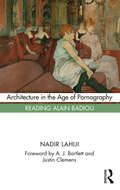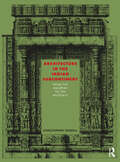- Table View
- List View
Architecture in Abjection: Bodies, Spaces and their Relations (International Library of Architecture)
by Zuzana KovarThis book marks a turning point in architectural theory by using philosophy to examine the field anew.Breaking from the traditional dualism within architecture – which presents the body as subject and space as object – it examines how such rigid boundaries can be softened. Zuzana Kovar thus engages with complementary and complex ideas from architecture, philosophy, feminist theory and other subjects, demonstrating how both bodies and bodily functions relate deeply to architecture. Extending philosopher Julia Kristeva's notion of abjection – the confrontation of one's own corporeality as something is excreted – Kovar finds parallels in the concept of the 'scaffold.' Much like living bodies and their products can impact on the buildings that house them – old skin cells create dust, menstrual blood stains, our breath heats and cools surfaces – scaffolding is similarly ephemeral and yet not entirely separable from the architecture it supports. Kovar shifts the conversation about abjection towards a more nuanced idea of architecture – where living organisms, building matter, space, decay and waste are all considered as part of a continual process – drawing on the key informing works of thinkers like Gilles Deleuze and Felix Guattari to do this. Including a number of experimental projects conducted in the spaces inhabited by the author herself to illuminate the theory at its core, the book forms a distinguished and pioneering study designed for practitioners and scholars of architecture, philosophy and visual culture alike.
Architecture in an Age of Uncertainty
by Benjamin FlowersIn the past two decades economic bubbles inflated and architectural spending around the globe reached fever pitch. In both well-established centers of capital accumulation and far--flung locales, audacious building projects sprang up, while the skyscraper, heretofore more commonly associated with American capitalism, seemed as if it might pack up and relocate to Dubai and Shanghai. Of course, much has changed in the past couple of years. In formerly free-spending Dubai, the tallest building in the world is now is named after the president of Abu Dhabi after he stepped in with last--minute debt financing. In cities across the United States, housing prices have nose-dived and cleared lots sit ready for commercial redevelopment that likely won't take place for another decade. Similar stories are not hard to find in many other nations. Architecture firms that swelled in flush days are jettisoning employees at a startling rate. In the context of economic instability (and its attendant social and political consequences), this edited volume brings together scholars, critics, and architects to discuss the present state of uncertainty in the practice and discipline of architecture. The chapters are organized into three main areas of inquiry: economics, practice, and technology. Within this larger framework, authors explore issues of security, ecological design, disaster architecture, the future of architectural practice, and the ethical obligations of the social practice of design. In doing so, it argues that this period has actually afforded architecture a valuable moment of self-reflection, where alternative directions for both the theory and practice of architecture might be explored rather than continuing with an approach which was so nurtured by capitalist prosperity and affluence.
Architecture in an Age of Uncertainty (Ashgate Studies In Architecture Ser.)
by Benjamin FlowersIn the past two decades economic bubbles inflated and architectural spending around the globe reached fever pitch. In both well-established centers of capital accumulation and far--flung locales, audacious building projects sprang up, while the skyscraper, heretofore more commonly associated with American capitalism, seemed as if it might pack up and relocate to Dubai and Shanghai. Of course, much has changed in the past couple of years. In formerly free-spending Dubai, the tallest building in the world is now is named after the president of Abu Dhabi after he stepped in with last--minute debt financing. In cities across the United States, housing prices have nose-dived and cleared lots sit ready for commercial redevelopment that likely won't take place for another decade. Similar stories are not hard to find in many other nations. Architecture firms that swelled in flush days are jettisoning employees at a startling rate. In the context of economic instability (and its attendant social and political consequences), this edited volume brings together scholars, critics, and architects to discuss the present state of uncertainty in the practice and discipline of architecture. The chapters are organized into three main areas of inquiry: economics, practice, and technology. Within this larger framework, authors explore issues of security, ecological design, disaster architecture, the future of architectural practice, and the ethical obligations of the social practice of design. In doing so, it argues that this period has actually afforded architecture a valuable moment of self-reflection, where alternative directions for both the theory and practice of architecture might be explored rather than continuing with an approach which was so nurtured by capitalist prosperity and affluence.
Architecture in Black: Theory, Space and Appearance
by Darell Wayne FieldsBased on analysis of historical, philosophical, and semiotic texts, Architecture in Black presents a systematic examination of the theoretical relationship between architecture and blackness. Now updated, this original study draws on a wider range of case studies, highlighting the racial techniques that can legitimize modern historicity, philosophy and architectural theory.Arguing that architecture, as an aesthetic practice, and blackness, as a linguistic practice, operate within the same semiotic paradigm, Darell Fields employs a technique whereby works are related through the repetition and revision of their semiotic structures. Fields reconstructs the genealogy of a black racial subject, represented by the simultaneous reading of a range of canonical texts from Hegel to Saussure to Henry Louis Gates, Jr.Combining an historical survey of racial discourse with new readings resulting from advanced semiotic techniques doubling as spatial arrangements, Architecture in Black is an important contribution to studies of the racial in Western thought and its impact on architecture, space and time.
Architecture in Black: Theory, Space and Appearance
by Darell Wayne FieldsBased on analysis of historical, philosophical, and semiotic texts, Architecture in Black presents a systematic examination of the theoretical relationship between architecture and blackness. Now updated, this original study draws on a wider range of case studies, highlighting the racial techniques that can legitimize modern historicity, philosophy and architectural theory.Arguing that architecture, as an aesthetic practice, and blackness, as a linguistic practice, operate within the same semiotic paradigm, Darell Fields employs a technique whereby works are related through the repetition and revision of their semiotic structures. Fields reconstructs the genealogy of a black racial subject, represented by the simultaneous reading of a range of canonical texts from Hegel to Saussure to Henry Louis Gates, Jr.Combining an historical survey of racial discourse with new readings resulting from advanced semiotic techniques doubling as spatial arrangements, Architecture in Black is an important contribution to studies of the racial in Western thought and its impact on architecture, space and time.
Architecture in Context: Designing in the Middle East
by Hassan RadoineArchitecture in Context: Designing in the Middle East provides a foundation for understanding the critical context of architecture and design in this region. It does this by: presenting a practical overview of architectural know-how in the Middle East, and its potential for cultivating a sense of place introducing local architectural vocabularies and styles, and how they can still be reactivated in contemporary design exploring the cultural and contextual meaning of forms as references that may influence contemporary architecture discussing important discourses and trends in architecture that allow a rethinking of the current global/local dichotomy. Highly illustrated, the book covers architecture and design in North Africa, the Levant, the Gulf, and Turkey, Iran and Iraq.
Architecture in Context: Designing in the Middle East
by Hassan RadoineArchitecture in Context: Designing in the Middle East provides a foundation for understanding the critical context of architecture and design in this region. It does this by: presenting a practical overview of architectural know-how in the Middle East, and its potential for cultivating a sense of place introducing local architectural vocabularies and styles, and how they can still be reactivated in contemporary design exploring the cultural and contextual meaning of forms as references that may influence contemporary architecture discussing important discourses and trends in architecture that allow a rethinking of the current global/local dichotomy. Highly illustrated, the book covers architecture and design in North Africa, the Levant, the Gulf, and Turkey, Iran and Iraq.
Architecture In Detail II
by Graham BizleyFollowing on from Graham Bizley’s successful Architecture in Detail, Architecture in Detail II presents forty case studies of detailing on recent construction projects. Over 150 full colour drawings and photos provide a reference compendium for the professional architect seeking detailing inspiration. Originally featured in Building Design’s In Detail magazine, the included projects represent some of the most interesting and innovative techniques in recent architecture. Graham Bizley’s beautifully presented detail drawings allow the architect to easily see how ideas and techniques can be applied to other projects. The book is organized by building type for quick and easy reference.
Architecture in Detail II
by Graham BizleyFollowing on from Graham Bizley’s successful Architecture in Detail, Architecture in Detail II presents 40 case studies of detailing on recent construction projects. Over 150 full colour drawings and photos provide a reference compendium for the professional architect seeking detailing inspiration. Originally featured in Building Design’s In Detail magazine, the included projects represent some of the most interesting and innovative techniques in recent architecture. Graham Bizley’s beautifully presented detail drawings allow the architect to easily see how ideas and techniques can be applied to other projects. The book is organised by building type for quick and easy reference.
Architecture in Detail II
by Graham BizleyFollowing on from Graham Bizley’s successful Architecture in Detail, Architecture in Detail II presents 40 case studies of detailing on recent construction projects. Over 150 full colour drawings and photos provide a reference compendium for the professional architect seeking detailing inspiration. Originally featured in Building Design’s In Detail magazine, the included projects represent some of the most interesting and innovative techniques in recent architecture. Graham Bizley’s beautifully presented detail drawings allow the architect to easily see how ideas and techniques can be applied to other projects. The book is organised by building type for quick and easy reference.
Architecture In Detail II (PDF)
by Graham BizleyFollowing on from Graham Bizley’s successful Architecture in Detail, Architecture in Detail II presents forty case studies of detailing on recent construction projects. Over 150 full colour drawings and photos provide a reference compendium for the professional architect seeking detailing inspiration. Originally featured in Building Design’s In Detail magazine, the included projects represent some of the most interesting and innovative techniques in recent architecture. Graham Bizley’s beautifully presented detail drawings allow the architect to easily see how ideas and techniques can be applied to other projects. The book is organized by building type for quick and easy reference.
Architecture in Development: Systems and the Emergence of the Global South
by AggregateThis extensive text investigates how architects, planners, and other related experts responded to the contexts and discourses of “development” after World War II. Development theory did not manifest itself in tracts of economic and political theory alone. It manifested itself in every sphere of expression where economic predicaments might be seen to impinge on cultural factors. Architecture appears in development discourse as a terrain between culture and economics, in that practitioners took on the mantle of modernist expression while also acquiring government contracts and immersing themselves in bureaucratic processes. This book considers how, for a brief period, architects, planners, structural engineers, and various practitioners of the built environment employed themselves in designing all the intimate spheres of life, but from a consolidated space of expertise. Seen in these terms, development was, to cite Arturo Escobar, an immense design project itself, one that requires radical disassembly and rethinking beyond the umbrella terms of “global modernism” and “colonial modernities,” which risk erasing the sinews of conflict encountered in globalizing and modernizing architecture. Encompassing countries as diverse as Israel, Ghana, Greece, Belgium, France, India, Mexico, the United States, Venezuela, the Philippines, South Korea, Sierra Leone, Singapore, Turkey, Cyprus, Iraq, Zambia, and Canada, the set of essays in this book cannot be considered exhaustive, nor a “field guide” in the traditional sense. Instead, it offers theoretical reflections “from the field,” based on extensive archival research. This book sets out to examine the arrays of power, resources, technologies, networking, and knowledge that cluster around the term "development," and the manner in which architects and planners negotiated these thickets in their multiple capacities—as knowledge experts, as technicians, as negotiators, and as occasional authorities on settlements, space, domesticity, education, health, and every other field where arguments for development were made.
Architecture in Development: Systems and the Emergence of the Global South
by Aggregate Architectural History CollaborativeThis extensive text investigates how architects, planners, and other related experts responded to the contexts and discourses of “development” after World War II. Development theory did not manifest itself in tracts of economic and political theory alone. It manifested itself in every sphere of expression where economic predicaments might be seen to impinge on cultural factors. Architecture appears in development discourse as a terrain between culture and economics, in that practitioners took on the mantle of modernist expression while also acquiring government contracts and immersing themselves in bureaucratic processes. This book considers how, for a brief period, architects, planners, structural engineers, and various practitioners of the built environment employed themselves in designing all the intimate spheres of life, but from a consolidated space of expertise. Seen in these terms, development was, to cite Arturo Escobar, an immense design project itself, one that requires radical disassembly and rethinking beyond the umbrella terms of “global modernism” and “colonial modernities,” which risk erasing the sinews of conflict encountered in globalizing and modernizing architecture. Encompassing countries as diverse as Israel, Ghana, Greece, Belgium, France, India, Mexico, the United States, Venezuela, the Philippines, South Korea, Sierra Leone, Singapore, Turkey, Cyprus, Iraq, Zambia, and Canada, the set of essays in this book cannot be considered exhaustive, nor a “field guide” in the traditional sense. Instead, it offers theoretical reflections “from the field,” based on extensive archival research. This book sets out to examine the arrays of power, resources, technologies, networking, and knowledge that cluster around the term "development," and the manner in which architects and planners negotiated these thickets in their multiple capacities—as knowledge experts, as technicians, as negotiators, and as occasional authorities on settlements, space, domesticity, education, health, and every other field where arguments for development were made.
Architecture in Digital Culture: Machines, Networks and Computation
by Socrates YiannoudesThis book examines the manifestations of architecture, cities, and design processes within digital culture. Adopting a comparative and critical method, the author looks at past and present encounters of the digital with architectural discourse and practice. Along three central themes – machines, networks, and computation – the book begins by discussing transformations of the analogy between architecture and the machine since the early twentieth century, foregrounding questions about the relations between architecture, humans, machines, and the environment. It moves on to the city, to observe how big data and smart city sustainable management systems have transformed historical visions of global networked cities. Lastly, it explores computational design thinking historically and in the context of complex systems, as well as the latest technical, social, and economic developments. Exposing possible drawbacks while still focusing on what is radically innovative, this book proposes a way toward more liberating, digital, and sustainable futures for architecture. An important read for architecture students, academics, and professionals, this book connects instances of digital architecture practice and discourse throughout the history of the digital culture paradigm and their ties with sociopolitical developments. It shares the possibility that these connecting lines may be the canvas for a novel architectural history of the recent past.
Architecture in Digital Culture: Machines, Networks and Computation
by Socrates YiannoudesThis book examines the manifestations of architecture, cities, and design processes within digital culture. Adopting a comparative and critical method, the author looks at past and present encounters of the digital with architectural discourse and practice. Along three central themes – machines, networks, and computation – the book begins by discussing transformations of the analogy between architecture and the machine since the early twentieth century, foregrounding questions about the relations between architecture, humans, machines, and the environment. It moves on to the city, to observe how big data and smart city sustainable management systems have transformed historical visions of global networked cities. Lastly, it explores computational design thinking historically and in the context of complex systems, as well as the latest technical, social, and economic developments. Exposing possible drawbacks while still focusing on what is radically innovative, this book proposes a way toward more liberating, digital, and sustainable futures for architecture. An important read for architecture students, academics, and professionals, this book connects instances of digital architecture practice and discourse throughout the history of the digital culture paradigm and their ties with sociopolitical developments. It shares the possibility that these connecting lines may be the canvas for a novel architectural history of the recent past.
Architecture in Formation: On the Nature of Information in Digital Architecture
by Pablo Lorenzo-Eiroa Aaron SprecherArchitecture in Formation is the first digital architecture manual that bridges multiple relationships between theory and practice, proposing a vital resource to structure the upcoming second digital revolution. Sixteen essays from practitioners, historians and theorists look at how information processing informs and is informed by architecture. Twenty-nine experimental projects propose radical means to inform the new upcoming digital architecture. Featuring essays by: Pablo Lorenzo-Eiroa, Aaron Sprecher, Georges Teyssot, Mario Carpo, Patrik Schumacher, Bernard Cache, Mark Linder, David Theodore, Evan Douglis, Ingeborg Rocker and Christian Lange, Antoine Picon, Michael Wen-Sen Su, Chris Perry, Alexis Meier, Achim Menges and Martin Bressani. Interviews with: George Legendre, Alessandra Ponte, Karl Chu, CiroNajle, and Greg Lynn. Projects by: Diller Scofidio and Renfro; Mark Burry; Yehuda Kalay; Omar Khan; Jason Kelly Johnson, Future Cities Lab; Alejandro Zaera-Polo and Maider Llaguno Munitxa; Anna Dyson / Bess Krietemeyer, Peter Stark, Center for Architecture, Science and Ecology (CASE); Philippe Rahm; Lydia Kallipoliti and Alexandros Tsamis; Neeraj Bhatia, Infranet Lab; Jenny Sabin, Lab Studio; Luc Courschene, Society for Arts and Technology (SAT); Eisenman Architects; Preston Scott Cohen; Eiroa Architects; Michael Hansmeyer; Open Source Architecture; Andrew Saunders; Nader Tehrani, Office dA; Satoru Sugihara, ATLV and Thom Mayne, Morphosis; Reiser and Umemoto; Roland Snooks, Kokkugia; Philip Beesley; Matias del Campo and Sandra Manninger SPAN; Michael Young; Eric Goldemberg, Monad Studio; Francois Roche; Ruy Klein; Chandler Ahrens and John Carpenter.
Architecture in Formation: On the Nature of Information in Digital Architecture
by Pablo Lorenzo-Eiroa Aaron SprecherArchitecture in Formation is the first digital architecture manual that bridges multiple relationships between theory and practice, proposing a vital resource to structure the upcoming second digital revolution. Sixteen essays from practitioners, historians and theorists look at how information processing informs and is informed by architecture. Twenty-nine experimental projects propose radical means to inform the new upcoming digital architecture. Featuring essays by: Pablo Lorenzo-Eiroa, Aaron Sprecher, Georges Teyssot, Mario Carpo, Patrik Schumacher, Bernard Cache, Mark Linder, David Theodore, Evan Douglis, Ingeborg Rocker and Christian Lange, Antoine Picon, Michael Wen-Sen Su, Chris Perry, Alexis Meier, Achim Menges and Martin Bressani. Interviews with: George Legendre, Alessandra Ponte, Karl Chu, CiroNajle, and Greg Lynn. Projects by: Diller Scofidio and Renfro; Mark Burry; Yehuda Kalay; Omar Khan; Jason Kelly Johnson, Future Cities Lab; Alejandro Zaera-Polo and Maider Llaguno Munitxa; Anna Dyson / Bess Krietemeyer, Peter Stark, Center for Architecture, Science and Ecology (CASE); Philippe Rahm; Lydia Kallipoliti and Alexandros Tsamis; Neeraj Bhatia, Infranet Lab; Jenny Sabin, Lab Studio; Luc Courschene, Society for Arts and Technology (SAT); Eisenman Architects; Preston Scott Cohen; Eiroa Architects; Michael Hansmeyer; Open Source Architecture; Andrew Saunders; Nader Tehrani, Office dA; Satoru Sugihara, ATLV and Thom Mayne, Morphosis; Reiser and Umemoto; Roland Snooks, Kokkugia; Philip Beesley; Matias del Campo and Sandra Manninger SPAN; Michael Young; Eric Goldemberg, Monad Studio; Francois Roche; Ruy Klein; Chandler Ahrens and John Carpenter.
Architecture in Global Socialism: Eastern Europe, West Africa, and the Middle East in the Cold War
by Łukasz StanekHow socialist architects, planners, and contractors worked collectively to urbanize and develop the Global South during the Soviet eraIn the course of the Cold War, architects, planners, and construction companies from socialist Eastern Europe engaged in a vibrant collaboration with those in West Africa and the Middle East in order to bring modernization to the developing world. Architecture in Global Socialism shows how their collaboration reshaped five cities in the Global South: Accra, Lagos, Baghdad, Abu Dhabi, and Kuwait City.Łukasz Stanek describes how local authorities and professionals in these cities drew on Soviet prefabrication systems, Hungarian and Polish planning methods, Yugoslav and Bulgarian construction materials, Romanian and East German standard designs, and manual laborers from across Eastern Europe. He explores how the socialist development path was adapted to tropical conditions in Ghana in the 1960s, and how Eastern European architectural traditions were given new life in 1970s Nigeria. He looks at how the differences between socialist foreign trade and the emerging global construction market were exploited in the Middle East in the closing decades of the Cold War. Stanek demonstrates how these and other practices of global cooperation by socialist countries—what he calls socialist worldmaking—left their enduring mark on urban landscapes in the postcolonial world.Featuring an extensive collection of previously unpublished images, Architecture in Global Socialism draws on original archival research on four continents and a wealth of in-depth interviews. This incisive book presents a new understanding of global urbanization and its architecture through the lens of socialist internationalism, challenging long-held notions about modernization and development in the Global South.
Architecture In Minutes (IN MINUTES)
by Susie HodgeIn this hyper-compact, fully illustrated guide to architecture, Susie Hodge outlines the history and theory of architecture from the earliest structures to the cutting-edge concepts of the present day. Along the way she profiles 200 key buildings, historic styles, architectural movements and celebrated architects from all around the world. Contents include the Greek orders, Roman engineering, Gothic architecture, the Renaissance, the Baroque, Revivalism, Art Nouveau, Modernism and Postmodernism, Futurism and Dynamic architecture along with architects like Inigo Jones, Christopher Wren, Gaudi, Frank Lloyd Wright, Le Corbusier and Frank Gehry.
Architecture in Motion: The history and development of portable building
by Robert KronenburgThe idea that architecture can be portable is one that grabs the imagination of both designers and the people who use it, perhaps because it so often forecasts a dynamic and creative solution to the complex problems of our contemporary mobile society, while at the same time dealing with issues of practicality, economy and sustainability. Architecture in Motion examines the development of portable, transportable, demountable and temporary architecture from prehistory to the present day. From familiar vernacular models such as the tent, mobile home and houseboat, to ambitious developments in military and construction engineering, all aspects of portable building are considered. Building on his earlier works Portable Architecture and Houses in Motion, Robert Kronenburg compares traditional forms of building, current commercial products and the work of innovative designers, and examines key contemporary portable buildings to reveal surprising, exciting and imaginative examples. He explores the philosophical and technological issues raised by these experimental and futuristic prototypes. By understanding the nature of transitory architecture, a new ecologically aware design strategy can be developed to prioritise buildings that 'tread lightly on the earth' and still convey the sense of identity and community necessary for an established responsible society. This book provides a unique insight into this pivotal field of design.
Architecture in Motion: The history and development of portable building
by Robert KronenburgThe idea that architecture can be portable is one that grabs the imagination of both designers and the people who use it, perhaps because it so often forecasts a dynamic and creative solution to the complex problems of our contemporary mobile society, while at the same time dealing with issues of practicality, economy and sustainability. Architecture in Motion examines the development of portable, transportable, demountable and temporary architecture from prehistory to the present day. From familiar vernacular models such as the tent, mobile home and houseboat, to ambitious developments in military and construction engineering, all aspects of portable building are considered. Building on his earlier works Portable Architecture and Houses in Motion, Robert Kronenburg compares traditional forms of building, current commercial products and the work of innovative designers, and examines key contemporary portable buildings to reveal surprising, exciting and imaginative examples. He explores the philosophical and technological issues raised by these experimental and futuristic prototypes. By understanding the nature of transitory architecture, a new ecologically aware design strategy can be developed to prioritise buildings that 'tread lightly on the earth' and still convey the sense of identity and community necessary for an established responsible society. This book provides a unique insight into this pivotal field of design.
Architecture in the Age of Artificial Intelligence: An Introduction to AI for Architects (PDF) (Architecture in the age of Artificial Intelligence)
by Neil LeachArtificial intelligence is everywhere from the apps on our phones to the algorithms of search engines. Without us noticing, the AI revolution has arrived. But what does this mean for the world of design? AI and the Design Revolution the first volume in the two-book series Architecture in the Age of Artificial Intelligence introduces AI for designers and considers its positive potential for the future of architecture and design. Explaining what AI is and how it works, the book examines how different manifestations of AI will impact the architectural profession. Highlighting current case-studies as well as near-future applications, it shows how AI is already being used as a powerful design tool, and how AI-driven information systems will soon transform the future of buildings and cities. Far-sighted, provocative and challenging, yet rooted in careful research and cautious speculation, this book, written by architect and theorist Neil Leach, is a must-read for all architects and designers including students of architecture and all design professionals interested in keeping their practice at the cutting edge of technology.
Architecture in the Age of Pornography: Reading Alain Badiou
by Nadir LahijiArchitecture, and its pedagogy in the academy, is dominated by the technology of image production that veils the ‘naked power’ behind its operation. It conforms to the principles of cultural logic of the society of the spectacle, consistent with neoliberal capitalism. The problem with this dominant pedagogy is that it violates the fundamental ethical imperative, putting architecture in direct contradiction with the ‘common good’. In addition, it has let architecture enter the brothel of pornographic capitalism which turns every object into an object of obscene gratification of the senses. In this book, Nadir Lahiji adopts Alain Badiou’s thesis from The Pornographic Age to demonstrate that contemporary architecture is in absolute complicity with the pornographic present. The traits that Badiou identifies in this age are manifestly visible in architectural surfaces which are subordinated to the same ‘regime of images’. Similarly to Badiou’s political indictments of the society which has given rise to the pornographic present, the book condemns the architecture that has lent its service to the same society with a license to consummate its transgression to better cater to the imperative of the ‘regime of images’. Transposing the conceptual categories in Badiou’s analysis to the critique of architecture’s pornographic turn in contemporary society, the book constructs a conceptual framework by which to demonstrate the specific manifestations of pornography in building. The book is aimed at architecture students at higher graduate and post-graduate levels.
Architecture in the Age of Pornography: Reading Alain Badiou
by Nadir LahijiArchitecture, and its pedagogy in the academy, is dominated by the technology of image production that veils the ‘naked power’ behind its operation. It conforms to the principles of cultural logic of the society of the spectacle, consistent with neoliberal capitalism. The problem with this dominant pedagogy is that it violates the fundamental ethical imperative, putting architecture in direct contradiction with the ‘common good’. In addition, it has let architecture enter the brothel of pornographic capitalism which turns every object into an object of obscene gratification of the senses. In this book, Nadir Lahiji adopts Alain Badiou’s thesis from The Pornographic Age to demonstrate that contemporary architecture is in absolute complicity with the pornographic present. The traits that Badiou identifies in this age are manifestly visible in architectural surfaces which are subordinated to the same ‘regime of images’. Similarly to Badiou’s political indictments of the society which has given rise to the pornographic present, the book condemns the architecture that has lent its service to the same society with a license to consummate its transgression to better cater to the imperative of the ‘regime of images’. Transposing the conceptual categories in Badiou’s analysis to the critique of architecture’s pornographic turn in contemporary society, the book constructs a conceptual framework by which to demonstrate the specific manifestations of pornography in building. The book is aimed at architecture students at higher graduate and post-graduate levels.
Architecture in the Indian Subcontinent: From the Mauryas to the Mughals
by Christopher TadgellDedicated to the tracing of continuity across sectarian divides, Christopher Tadgell’s History of Architecture in India (1989) was the first modern monograph to draw together in one volume all the strands of India’s pre-colonial architectural history – from the Vedic and Native traditions of early India, through Hindu, Buddhist, Islamic and secular architecture. This comprehensive revision, Architecture in the Indian Subcontinent: From the Mauryas to the Mughals, expands the structure to acknowledge the great advance in scholarship across this extremely complex subject over the last three decades. An understanding of Indian history and religion is the basis for understanding the complex pattern of relationships in the evolution of architecture in the subcontinent. Therefore, background material covers major invasions, migrations, dynastic conflicts and cultural and commercial connections, the main religious developments and their significance and repercussions, and external architectural precedents. While avoiding the usual division of the subject into ‘Buddhist and Hindu’ and ‘Islamic’ parts in order to trace continuity, the importance of religion, symbolism and myth to the development of characteristic Indian architectural forms in all their richness and complexity is fully explained in this fully illustrated account of the subcontinent’s architecture.
